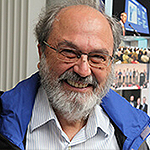
Andrew Gammie
Dr. Andrew Gammie is the Clinical Engineer at the Bristol Urological Institute, UK. He is active in publications and research in urodynamics for drug trials, data mining and device assessment and development. He participates in numerous training courses promoting quality in urodynamic measurements, and chairs the International Continence Society Urodynamic Equipment Working Group.
Limitations of current approaches in Urodynamics
ABSTRACT: Urodynamics assesses the function of the lower urinary tract during urine storage and voiding. Pressure and flow are measured and symptoms recorded during an interactive test. Imaging can be added when influence on the upper urinary tract is suspected or when surgery has modified the tract. The test can be carried out with the patient in the clinic, connected to computer based recording equipment, or while they carry out activities of daily living while wearing a portable monitor. Challenges for the engineer in urodynamics include measurement of true intra-patient pressures via catheters, assessment of bladder muscle contractile power, recognition of the patterns of urine flow rate curves and developing techniques of non-invasive assessment. Mathematical techniques are proving useful in solving some of these problems, but the limitations of approaches currently in use will be discussed.

Ayesha Bint-e-Siddiq
Ayesha Bint-E-Siddiq MEng( Hons) Ayesha Bint-E-Siddiq is a biomedical engineer, currently a PhD candidate at iMBE, University of Leeds. She has worked on projects involving computational modelling of flow dynamics in stented ureters and is currently developing novel methods of modelling spinal ligaments computationally. She has a keen interest in computational methods used to facilitate advances in medical technologies and interventions.
Ayesha will be presenting a co-authored paper with Dr. Noors Buchholz.

Bahareh Vahabi
Professional Biography
Dr Bahareh Vahabi is a Senior Lecturer in Physiology and the International Partnership Coordinator at University of the West of England, a Research Fellow at the Bristol Urological Institute/University of Bristol and an Associate Professor at University of Maastricht, The Netherlands. Dr Vahabi has forged a distinguished academic career combining research and teaching at leading universities and hospitals in the United Kingdom.
The validation of a functional, isolated large animal bladder model for physiological experimentation
ABSTRACT: Our knowledge of bladder function remains incomplete and experimental approaches such as muscle strip experiments, though central to our current understanding, fail to reproduce the complex network of cell-cell interactions that underpin normal bladder function. Improving our understanding of bladder physiology necessitates the use of whole organ preparations and to date most of this work has been done using bladders from small rodents. Extrapolating findings generated using small laboratory animals to lower urinary tract physiology of large animals and to the clinical context is difficult, and requires careful validation. In order to overcome some of these limitations, the aim of our research has been to develop an experimental model using an isolated whole pig bladder, which could be used to study the integrative physiology of the bladder. Using a pump perfusion system, the viability of an isolated large animal bladder can be maintained for a prolonged period of time even after a limited period of warm and cold ischaemia. This experimental approach can be used to study whole organ function of large animal bladders, and the potential for different routes of drug administration may help discern the relative contribution of different cell types in tissue function.

Dirk Lange
Dr. Lange is an Associate Professor in the Department of Urologic Sciences at the University of British Columbia, Canada and Director of Basic Science Research at The Stone Centre at Vancouver General Hospital. Dr. Lange’s translational research program focuses on studying mechanisms that drive indwelling ureteral stent-associated complications, including understanding how the ureter responds to indwelling stents. As a part of this, Dr. Lange studies the effects on ureteral peristalsis, one of the important factors that needs to be considered when developing new stents.
The impact of indwelling stents on ureteral function

Dominik Obrist
ARTORG Center for Biomedical Engineering Research
University of Bern
Switzerland
Short bio:
Dominik Obrist studied mechanical engineering at ETH Zurich (1991-1997) and earned a PhD in applied mathematics from the University of Washington in Seattle (2000). After working for the supercomputer company Cray, he joined the Institute of Fluid Dynamics of ETH Zurich as senior researcher in 2005. In 2013, he was appointed Professor for Cardiovascular Engineering at the University of Bern.
Computational modelling of fluid-structure interaction in biomedical flow systems
ABSTRACT: Biomedical flow systems comprise flows at a wide range of Reynolds numbers interacting with structures made of complex materials (soft tissue). Computational modelling of such fluid-structure interaction (FSI) problems requires efficient solvers for structure and flow as well as robust schemes for coupling the two phases.
We discuss an FSI framework based on the immersed boundary method suitable for such problems. This includes a finite element (FE) solver for the full elastodynamics equations of the structure, a Navier-Stokes solver using high-order schemes and variational transfer for coupling the FE mesh of the structure and the Cartesian grid for the flow. Next to the study of numerical properties of the FSI framework, we discuss methods for optimizing the code for massively-parallel execution and for using GPUs. Finally, we will study different FSI test cases including a benchmark for solid inertia and a problem with transitional flow past an obstacle made of a material with fibres.

Edwin Jager
Dr. ir. Edwin Jager
Associate Professor
Bionics and Transduction Science Unit
Dept. Physics, Chemistry and Biology (IFM)
Linköping University
581 83 Linköping, Sweden.
Edwin Jager received his M.Sc.Eng. degree (ir) in Applied Physics at University of Twente, the Netherlands, specializing in transduction science and his PhD in Applied Physics at Linköping University, Sweden, in 2001. From 2000 to 2007 he was a co-founder and CTO of the spin-off company Micromuscle AB. He returned to academia in 2007 where he since 2016 leads his Unit. He is visiting professor at the University of Wollongong, Australia.
His research interests include electroactive polymers, polymer (micro-) actuators, bioelectronics, electroactive surfaces and scaffolds, textile actuators, and lab-on-a-chip devices for cellular mechano-biology (mechanotransduction), medical devices and soft (micro-)robotics.
Microphysiological devices to study mechanotransduction in urinary tract
E.W.H. Jager1and K. Svennersten2
1 Dept. of Physics, Chemistry and Biology, Linköping University, SWEDEN
2 Dept. of Molecular Medicine and Surgery, Karolinska Institute, Stockholm, SWEDEN
ABSTRACT: Cellular mechanotransduction is crucial for physiological function in the lower urinary tract. The bladder is highly dependent on the ability to sense and process mechanical inputs, illustrated by the regulated filling and voiding of the bladder. However, the mechanisms by which the bladder integrates mechanical inputs and controls e.g. the smooth muscles, remain unknown. To date no tools exist that satisfactorily mimic in vitro the dynamic micromechanical events initiated e.g. by an emerging inflammatory process or a growing tumour mass in the urinary tract. There is a need for tools to study these events on a single cell level or in a small population of cells.
We have developed a micromechanical stimulation chip that can apply physiologically relevant mechanical stimuli to single cells to study mechanosensitive cells in the urinary tract. The chips comprise arrays of polymer microactuators based on the electroactive polymer polypyrrole (PPy). PPy offers unique possibilities and is a good candidate to provide such physiological mechanical stimulation, since it is driven at low voltages, is biocompatible, and can be microfabricated. The PPy microactuators can provide various mechanical stimulation patterns to single cells or clusters of cells, including controls, all integrated on one single chip, without the need to pre-prepare the cells. In this lecture, the fabrication and functioning of the mechanochips will be explained. We will report how we have used the chips to study mechanoresponse of urothelial. We will show that urothelial cells are viable on our microdevices and how the cells respond to such a micro-mechanical stimulation.

Eldad Avital
Dr Eldad Avital FRAeS
Dr Avital is a Reader in Computational Fluids and Acoustics at the school of engineering and materials science, Queen Mary University of London. He has published 65 journal papers, many in bio-fluid dynamics; (i) Ureter urine flow (ii) Red blood cell flow (iii) Blood fluid machinery and (iv) Nasal aerodynamics, in collaboration with engineers, scientists and medical consultants. He is a fellow of the Royal Aeronautical Society and a member of the UK/EPSRC turbulence consortium.
High performance computations of bio-fluid dynamics
ABSTRACT: The rapid development of computational techniques for fluid and structural dynamics in the last few decades has a significant benefit for the bio-fluid sector. This ranges from gaining new understanding of fluid flow in the body to a virtual lab where new ideas of devices and surgical procedures can be assessed without risk or discomfort. However, the transfer of numerical methodology from areas as aerospace engineering to bio-fluid has proven to be not straight forwards. Bio-fluid problems generally exbibit complex structural geometry that differs from person to person and strong interaction between the flexible structure of the vessel and fluid flow as in the ureter. The fluid can be composed of several components as in blood and the flow passages can be narrow but still essential for the flow as in the nasal cavity.
In this session we will look at several computational approaches of fluid dynamics that can account for the flexibility of the structure, from body-fitted grids to immersed boundary approach. We will discuss ways to adapt these approaches to the requirements of bio-fluid problems. The discussion will range from simple examples to fully complex case studies as urine flow in the ureter. Finally, methods of mimicking structural geometry in the computational model will be discussed, including the possibilities of simplification in order to enhance computational efficiency.

Gerard Apodaca
Dr. Apodaca is a tenured Professor of Medicine and Cell Biology at the University of Pittsburgh School of Medicine. His current research is focused on mechanotransduction and the regulation of barrier function in the urothelium, a specialized epithelial tissue that lines the renal pelvis, ureters, and bladder. He has published over one hundred manuscripts, review articles, and book chapters, and his work has been cited by others thousands of times. His research was previously awarded an NIH MERIT grant and his current funding includes an NIH R01 grant to study the role of uroplakins in urinary tract function and development, and an additional grant to understand how aging impacts lysosome and mitochondrial function in the urothelium. In addition to serving as the Director of the Kidney Imaging Center, a morphology core focused on imaging the epithelial cells of the upper and lower urinary tract, he has served on scores of NIH review panels, and is currently on the Editorial Board of the American Journal of Physiology-Cell Physiology, AJP-Renal Physiology, the journal Bladder, the journal Traffic, and Frontiers in Cell and Developmental Biology. He has a long track record of training undergraduate students, graduate students, medical students, and postdoctoral fellows, and has previously directed graduate programs as well summer undergraduate research programs. He is currently a member of the University of Pittsburgh Academy of Master Educators.
Maintenance of the urothelial barrier during bladder filling and voiding

Jenny Southgate
Professor Jenny Southgate trained at the Imperial Cancer Research Fund, London and has a PhD in epithelial cell biology from the University of Leeds. At the University of York she is Professor of Molecular Carcinogenesis and Director of the Jack Birch Unit, a research unit specialising in the biology, pathogenesis and engineering of human urothelial cells and tissues.
Design lessons from biology: evolved for function
ABSTRACT: The inside of the urinary tract is lined by a unique epithelial tissue, the urothelium. Urothelium is not only recognised for its specialisation as one of the tightest barriers in the body but, despite being a low turnover (mitotically-quiescent) tissue, it is also acknowledged as one of the most rapidly repairing (regenerative) of all mammalian tissues. These extreme characteristics reflect the evolutionary selection for an epithelium that has developed as a urinary barrier from two distinct embryological derivations. As a barrier, the urothelium is highly specialised not only to accommodate urine storage, but also as the first line of defence against infection from uropathogenic bacteria. In this lecture, I will discuss how the use of experimental systems to study urothelial cell properties underpinning barrier development, repair and innate defence can generate new insight of human urinary tract pathologies and strategies for therapy.

Jordi Alastruey
Biomedical Engineering Department, Kings College
Dr Jordi Alastruey is a Senior Lecturer of Biomedical Engineering at King's College London. He obtained a PhD in Bioengineering from Imperial College London in 2006 and was a British Heart Foundation Research Fellow from 2009 to 2013. His lab (www.haemod.com) specialises in cardiovascular haemodynamics.
Arterial blood flow: Modelling and analysis using reduced-order models
ABSTRACT: Cardiac contraction and its interaction with the distensible arterial walls generate pulse waves. These lead to a rhythmical expansion and contraction of arteries (e.g. producing the pulse felt on the wrist) and to changes in blood pressure and flow with time and along the axis of arteries. Pulse wave signals are influenced by the cardiac and vascular systems, making them a rich source of information on cardiovascular health.
This presentation will describe mathematical and numerical tools to simulate arterial blood flow and interactions between the heart and the vasculature based on reduced-order models. These are obtained from a mathematical simplification of the full three-dimensional (3-D) Navier-Stokes equations, leading to 1-D and 0-D formulations that feature a much smaller computational cost than 3-D modelling and a reasonable accuracy. Several experiments to test the accuracy of 1-D/0-D models will be shown, including comparisons of simulated 1-D/0-D model arterial pulse wave signals against in vitro data in a 1:1 scale cardiovascular simulator rig of the aorta and its larger branches, numerical data obtained by solving the full 3-D equations in compliant domains, and in vivo data in humans. The presentation will also include some examples in which reduced-order models have been used to analyse pulse wave signals in order to assess cardiovascular function.
Reduced-order modelling provides a good balance between accuracy and computational cost, making it appealing for clinical applications involving the analysis of pressure, flow and area waveforms in deformable vessels such as arteries.

Joshua Owen
Doctor Joshua Owen is Researcher at the Oxford Centre for Drug Delivery Devices. His current research focuses on many areas of improving therapy such as enhanced delivery of radiopharmaceuticals, overcoming bacterial biofilms and reducing tumour hypoxia. He has over twenty publications and three patents.
Ultrasound enhanced delivery of therapeutic agents for the treatment of biofilms associated with Urinary Tract Infections
ABSTRACT: Urinary tract infections are among the most prevalent infectious diseases worldwide, leading to significant morbidity and mortality at a substantial economic cost. Bacterial biofilms play an important role in urinary tract infections being responsible for persistent infections and relapses overcoming conventional antibiotic treatments and immune responses. One promising method for overcoming biofilms in urinary tract infections is through the use of ultrasound: a longitudinal pressure wave with a frequency greater than 20 kHz. Ultrasound can be efficiently propagated through the body and localised to sub-millimetre tissue domains, exposing the tissue to alternating cycles of compression and rarefaction of microsecond duration. These waves can be used to induce the expansion and collapse – cavitation - of a gas bubble from an agent such as a coated microbubble, which can be injected directly into the bloodstream. Ultrasound assisted delivery has shown the capability to enhance the distribution and penetration of therapeutic molecules at a target site. For the treatment of biofilms we have developed antibiotic (gentamicin) loaded nanoparticles bound to cavitation agents (microbubbles). When activated by ultrasound these agents deliver gentamicin to the biofilms with enhanced penetration and distribution for greater therapeutic effect. The equipment is readily available in the clinic for low cost and microbubbles are currently used clinically along with the antibiotics allowing for ease of clinical translation. Ultrasound enhanced delivery offers great promise for the targeted treatment of urinary tract infections.

Louise Rouse
MBChB, BHB
I am an Endo-urology fellow working at the Churchill Hospital Urology Department in Oxford. As part of my fellowship year I am completing a research project through University of Oxford Institute of Biomedical Engineering. My research focuses on renal pelvic pressures during ureteroscopy.
Porcine pelvic pressures: A simulated ureteroscopy experimental platform
ABSTRACT: Ureteroscopy (URS) for the management of urinary calculi and urothelial malignancies requires irrigation to obtain adequate visualisation. During URS renal pelvic pressures (RPP) can rise significantly to levels greater than the often accepted threshold of 30 cmH2O for pyelovenous and pyelolymphatic backflow. This in turn can potentially increase sepsis risk. Ureteric access sheaths (UAS) act to facilitate renal drainage during URS thus lowering RPP. Various tools can be used during ureteroscopy to aid in achieving adequate irrigant flow and resultant clear visualisation. These include bolus pumps and pressure bags. We have developed an instrumented platform to measure fluid pressures during URS in ex vivo porcine kidneys with attached ureter employing various combinations of these tools. Our research is ongoing however current results suggest that in standard ureteroscopy conditions the use of a UAS significantly lowers RPP with steady state pressures <14cmH20 and even with boluses of fluid never exceeding 30cmH20. Conversely in the absence of a UAS steady state RPP approaches 30cmH20 and reaches nearly 60cmH20 with boluses. I hope to be able to share with you up to date data from my current experiments using pressure bag at the time of the training school.

Marc Schneider
Urinary tract function assessment in mice and rats
Abstract: Rodents, especially mice and rats, are the most frequently used laboratory animals for urinary tract function research. The function of the urinary tract is simple: urine storage and voiding. However, despite this simplicity of function, the reliable assessment is a challenge. Urodynamic investigation is the gold standard assessment for urinary tract assessment in humans. In animals this reflects a challenge since animals are unable to show urgency and anaesthesia may significantly change findings.
The talk will give an overview of up to date technics for urinary tract assessment in Mice and Rats.

Mark Thompson
Dr Mark S Thompson
Institute of Biomedical Engineering, Department of Engineering Science, University of Oxford
Mechanobiology is key knowledge for translation of new regenerative therapies into the clinic. The Oxford Mechanobiology Group has developed excellence in measuring and modelling the microstructural deformation of living tissues placing us in the forefront of efforts to prevent damage and degeneration and stimulate regeneration of mechanically critical tissues.
Microstructural deformation of bladder tissue

Noor Buchholz
Dr. Noor NP Buchholz MBBS (D), MD (CH), FSSU (CH), FKNMG (NL), MFMLM (UK)
Sobeh’s Vascular & Medical Center
Dr. Noor Buchholz was trained in Germany, Switzerland and Australia. He has worked as a Consultant Urologist in Pakistan, Netherlands, and UK. Since 2014, he has moved his clinical work to Dubai/ UAE. He is the founding chairman of U-merge London, a global medical platform facilitating knowledge exchange and transfer from affluent to less affluent countries.
He is the world’s leading expert in the novel technology of permanent metal stenting of the urinary tract which is one of his major research interests.
The influence of stent encrustation on ureteral flow – a computational fluid dynamics analysis
Bint-E-Siddiq A, Buchholz N
ABTRACT:
Introduction
The flow characteristics of unstented and stented ureters are shown to differ in the literature. Furthermore the encrustation is thought to deposit preferentially at either end of the stent causing obstruction in the flow. Computational fluid dynamics (CFD) may provide a non-invasive approach to evaluate Urodynamics in a stented ureter.
The aim of this study was to investigate the changes in flow properties with the insertion of a stent to predict the site and development of encrustation using CFD.
Method
- Gambit 2.1.6 was used to build a 2-dimensional simplified and symmetric stented ureter model.
- Simulation in Fluent to predict the areas prone to initial encrustation with spatial attention to the effects of stent and varying degree of lumen size, to mimic encrustation
- The flow was modelled as steady, incompressible and laminar flow with fluid being urine properties assumed to be those of liquid water i.e. viscous and Newtonian fluid.
- The pressure, velocity, and shear stress contours, velocity vectors and path lines ofall the above were examined to extract the depictions of flow at particular locations to predict the areas prone to encrustation.
- Subsequent models with reduced lumen, mimicking encrustation, were simulated.
Results
It was found that the proximal end of stent in a stented ureter is prone to initial build-up and development of encrustation as the velocity magnitude and dynamic pressure plots show lowest values in these regions while the static pressure is at its highest
Conclusion
CFD models have a potential implication on clinical investigations. The models, in conjunction with imaging modalities have the potential to pin-point the exact areas prone to encrustation. Employing Immersed Boundary Method would make the modelling simpler and easier, would alleviate the accuracy and save up on the computational cost of the solution procedure.

Sandra Wilks
Biological Sciences & Health Sciences
University of Southampton
After completing a PhD in marine microbial ecology, my research work has concentrated on understanding biofilms, including those associated with drinking water and food production. Following the award of an Institute for Life Sciences Knowledge Mobilisation Senior Fellowship in Healthcare Technologies, I am now leading a research programme on urinary biofilms and medical devices.
Deciphering the crystal maze: understanding bacterial biofilms
Bacterial biofilms are coordinated communities of bacteria able to colonise any medical device used within the body. The impact of biofilm-related infections is still not fully understood but we know they have increased tolerance to antibiotics and can have high levels of antimicrobial resistance development. In urinary catheter users, long-term use results in an almost permanent colonisation of urine and high risk of urinary tract infections and blockages. The presence of urease-producing species such as Proteus can lead to rapid elevation of the urine pH and formation of large amounts of crystals and encrustations. Understanding how these biofilms form and persist can aid in the development of new materials or control strategies.
Using episcopic differential interference contrast (EDIC) microscopy, we have been able to define four stages in crystalline biofilm formation on urinary catheters; from early attachment events to complex crystal formation and colonisation. The use of high resolution micro-computed tomography is being explored. Applying such advanced imaging techniques can provide important information and these will be explored alongside the advantages and limitations of laboratory model systems.
Improving our understanding of biofilm formation on medical devices is important in informing device design, development of new materials and new clinical treatment strategies.

Yannis Missirlis
Professor of Biomechanics & Biomedical Engineering at University of Patras, Greece
Professor Missirlis is a pioneer of the Interdisciplinary Sciences of Biomechanics, Biomaterials, Biomedical and Tissue Engineering in Greece
All the appropriate signals are necessary for engineering proper tissues: a prerequisite for successful tissue engineering
ABSTRACT: The highly interdisciplinary area of tissue engineering, by its nature, involves several fields of research from basic materials development to stem cell handling to clinical applications. While the need for quick applications is driven by necessity we are still far away from understanding how the hybrid system of material scaffolds=cells= biomolecules operates optimally either in=vitro (in a bioreactor) or in=vivo. In our effort to monitor some basic responses of particular cells to specific environments we have developed a bioreactor able to supply a multitude of mechanical cues, singly or in combination to endothelial cells. In this presentation we will provide evidence of the importance of substrate stretching and frequency of stretching, of the shear rate of the flowing feeding medium on top of the cells, and of a simulated microgravity environment to the morphological adaptation of the cells and the rearrangement of its cytoskeletal proteins for each particular adaptation. It will also be shown how the combination of these signals correlates with specific gene expressions.


